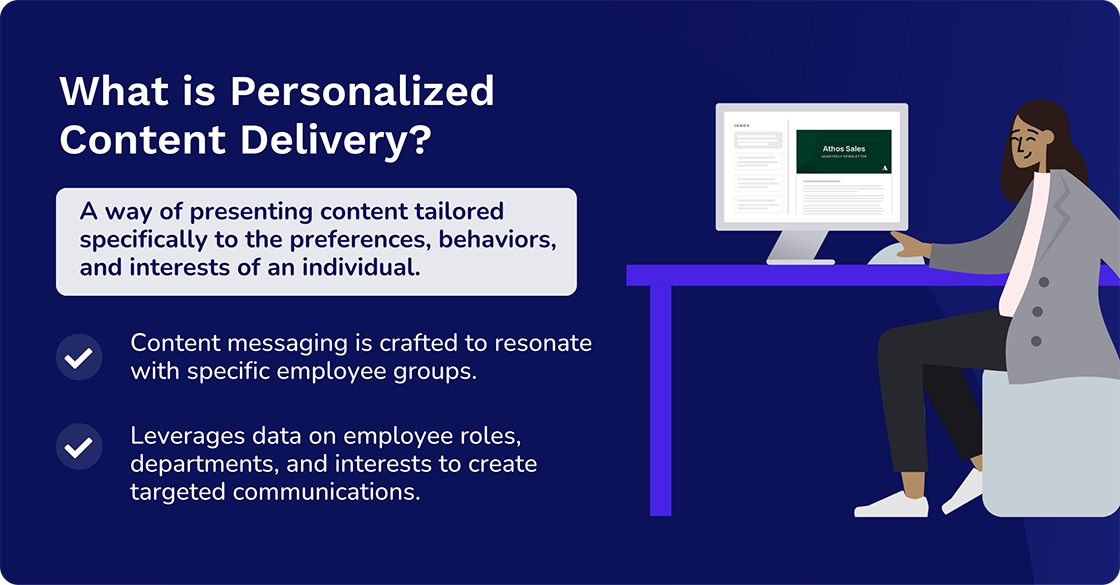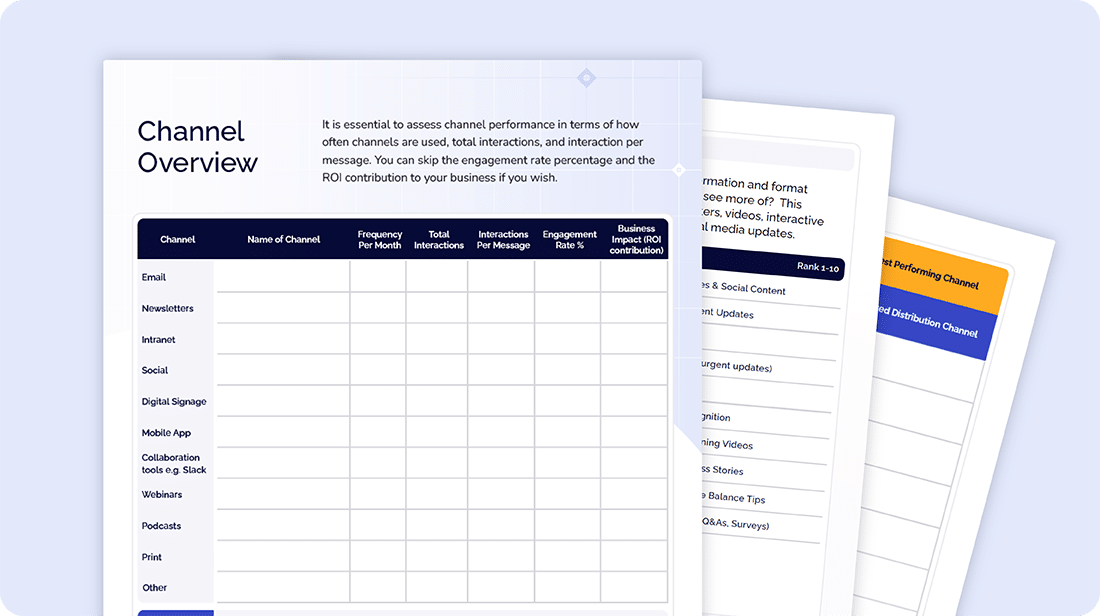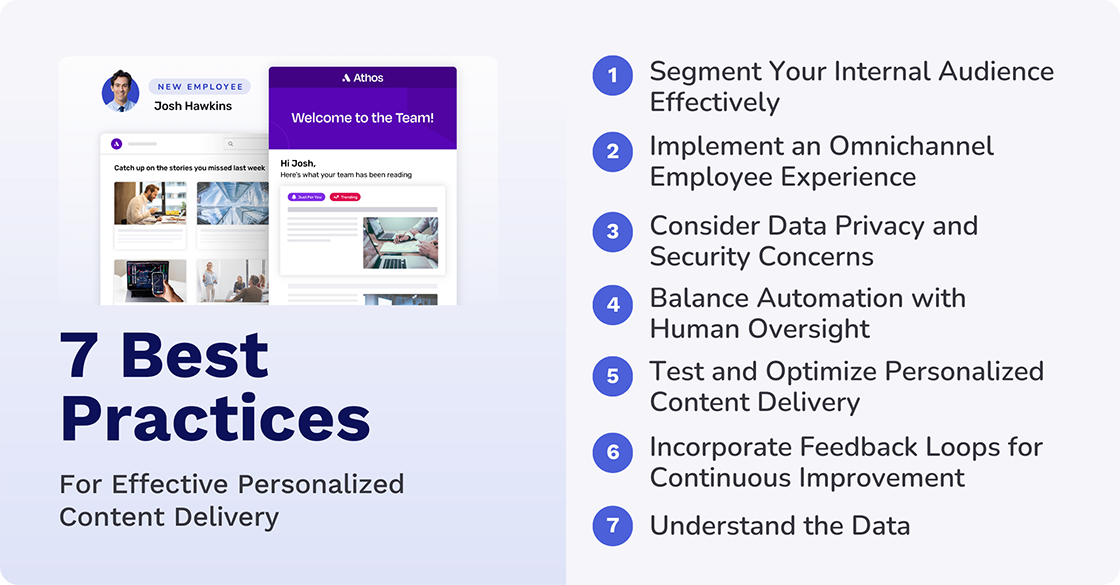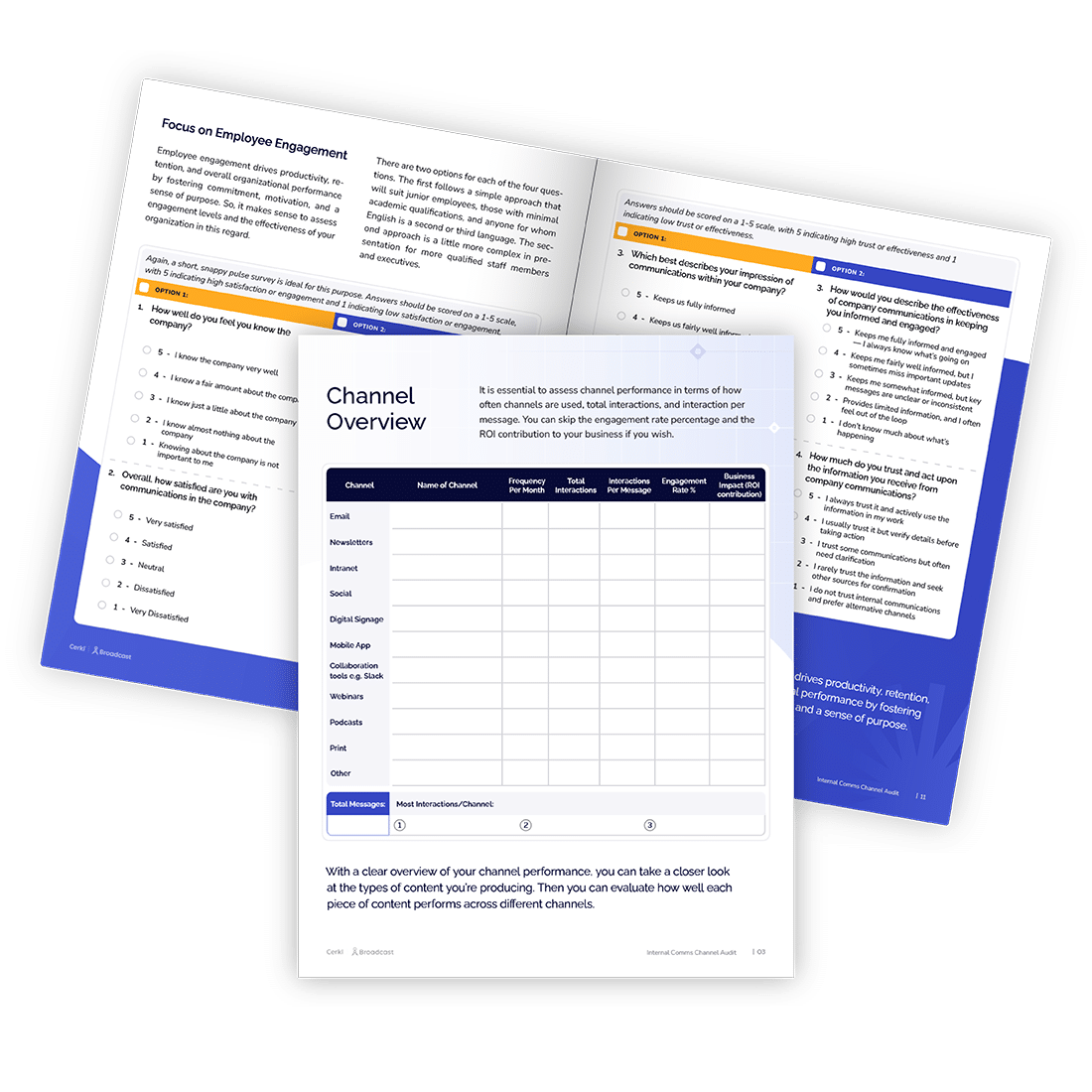Personalized content delivery refers to the practice of tailoring online content to an individual's interests and preferences. It involves using data on a person's behavior, browsing history, demographics, and other factors to create a unique experience for each user.

.png)
Strategy is an important component of internal communications. Ensure you’re communicating through the right channels at the right frequency with our Internal Communications Channel Audit worksheet.
Access NowThe realm of personalized content delivery is constantly expanding, and for businesses of all types and sizes, it has become more important than ever. A customized approach can improve internal communications, strengthen employee engagement, and increase productivity and retention. However, there are many challenges that internal communicators face when it comes to content personalization and its transmission.
And it’s not the only challenge they have to overcome. There are multiple challenges that internal communicators constantly face, all with their own particular pains. Cerkl's Head of Customer Success, Maddy Rieman, identified 10 top challenges at our workshop held in February 2024 at the 11th Annual Strategic Internal Communications — West Conference in San Francisco.
We’ve been featuring these challenges, one by one, every week, in an endeavor to mitigate their intensity and empower communicators to succeed in the pivotal role they play. So far, we’ve featured posts that discuss the pains associated with:
This, our sixth post, provides an overview of personalized content delivery, its benefits, best practices for implementing it effectively, and the role of artificial intelligence in this business landscape.
Gallagher’s State of the Sector 2023/24 survey report states that there’s hope that personalization and automation are poised to be tech game-changers. But they also ask:
“Platforms and apps; channels and Artificial Intelligence — with so much tech available, how are communicators cutting through the digital noise to ensure they’re reaching employees effectively?”
Gallagher
Ultimately, we will show internal communicators why content personalization is so important.
Personalized content delivery (also called dynamic content delivery) is a forceful way of presenting content tailored specifically to the preferences, behaviors, and interests of an individual. More specifically, in internal communications, personalized content delivery means crafting messages that resonate with specific employee groups. This involves leveraging data on employee roles, departments, and interests to create targeted communications and enhance the overall experience for each user.
As Maddy points out, companies like Amazon, Netflix, and Spotify have nailed content personalization. “Each of these systems can adequately personalize my experience with their platform or their service at scale. My Netflix homepage or my Spotify weekly playlist will be entirely different from every other person’s based on my interactions, and they know what I like or dislike.”
“No two employees are the same. Personalized content delivery means building a unique experience for every employee.”
Maddy Rieman
Content personalization relies on data gathered from various interactions with the user, such as demographic, contextual, and behavioral data. By leveraging this data, content creators can curate experiences uniquely suited for each user, enhancing the online experience significantly. Customization can range from presenting recommended reading on a landing page to sending tailored employee engagement campaigns.
“Respondents foresee personalization and automation serving the right information to the right people at the right time in the next five years with advances in technology supporting this.” Gallagher

At its core, this process involves analyzing large amounts of employee data using powerful personalized content delivery algorithms. These are designed to sift through the data, identifying patterns of behavior and preference. This enables a level of tailoring online content that was once impossible. AI and machine learning have pushed the boundaries further, enabling real-time customization that can adapt to user behavior changes, creating a continually optimized and improved user experience.
It’s been used to improve the consumer experience for a very long time. So, says Maddy, “We often ask why it has taken so long for the employee experience to get the same level of attention as a consumer-grade experience. It’s about time internal communications receive the same level of attention, respect, and advocacy that marketing teams have been receiving for years and years.”
Personalizing the concept of “at scale,” she describes it as “the ability for communicators to create one-to-one communications for every employee and their entire company… without having to sit down and write a unique comms to every individual employee.”
Upgrade your company’s internal comms to enhance employee communication

The Top Employers Institute World of Work Trends Report 2023 identifies “an unprecedented level of personalization in the everyday employee experience” as a top trend. It’s part of what they call “a powerful human shift towards respecting individuality and valuing difference.”
In an article about personalization, Top Employers Institute regional marketing manager for the Asia-Pacific market (APAC), Saadiq Samodien draws attention to the fact that “personalization has become a necessity for organizations that want to create a productive workforce. And the role of digital and technology cannot be understated as it uses intuitive tech to personalize the experience.”
Essentially, employees expect to be treated as internal customers. “As the employee experience takes center stage as a critical differentiator, personalization emerges as the key to its success,” he says. Already, there has been a substantial increase in employee involvement in engagement action plans in the APAC region — rising from 75% in 2022 to 84% in 2023.
Top Employers have found numerous benefits of personalization, he says. One is that it helps organizations to create a positive work culture. This statistic rose from 58% in 2022 to 72% in 2023. Others include increased employee engagement, improved performance management, and an improved sense of autonomy for employees.
We know that employees are bombarded with an avalanche of content daily, leading to what’s commonly referred to as information overload.
Several Gartner research reports tell the story with figures. For example, in July 2023 they stated that 46% of leaders and 35% of managers say they experience information overload. This is more than any other employee group experiences. More generally, they state 27% of employees and 38% of managers feel overwhelmed by this mounting information.

“These feelings of information overload can have real, negative business impacts, including less alignment with corporate strategy and a lower intent to stay in the organization.” Gartner
Personalized content delivery offers a solution by filtering through the noise to present only the most relevant and engaging content for each employee. This enhances the online experience and improves the efficiency of internal communications campaigns by ensuring that HR efforts are focused on delivering dynamic content that resonates.
The effectiveness of personalized content is evident in platforms like social media, where personalized content delivery algorithms help curate news feeds according to each user's preferences, significantly enhancing the digital experience. Similar concepts apply in internal organizational settings, where filtering information can help employees access the most relevant data without being overwhelmed.
Upgrade your company’s internal comms to enhance employee communication

Delivering content that is tailored to the specific needs and roles of employees can revolutionize engagement and information retention. Instead of generic company-wide email communications, mass content personalization allows for messages that speak directly to the concerns, responsibilities, and interests of individual departments or even employees. This fosters a sense of inclusion and recognition among employees, contributing to a more positive work environment.
For example, using content personalization, HR departments can send out health benefits information only relevant to employees with families. Or the IT department can target communications about new software updates solely to those it impacts. This level of customization ensures that messages are more likely to be read and acted upon, streamlining processes and reducing information clutter within an organization.
Engaged employees are more motivated, productive, and likely to stay with a company. Personalized content delivery plays a key role in fostering this engagement. By utilizing content personalization to make information relevant and tailored to individual employees, companies can demonstrate that they value and understand the unique needs and preferences of their workforce. This can significantly boost morale and commitment.
Additionally, content personalization can facilitate a more seamless integration of new employees or the adoption of new policies and technologies by making relevant information easily accessible. Personalizing learning and development opportunities according to individual career goals and skill gaps can further enhance engagement.
When employees are highly engaged and receive information that is directly relevant to their roles and interests, productivity naturally increases. Personalized content delivery ensures that employees are not wasting time sifting through irrelevant information, allowing them to focus on their work with greater efficiency. This optimized workflow directly translates to higher output and better results for the organization.
Moreover, the benefits of content personalization extend to employee retention. A workplace that values personalized communication and information delivery shows its commitment to addressing individual needs and preferences. This recognition can significantly influence an employee's decision to stay with an organization, reducing turnover rates and the associated costs of recruitment and training new staff. By investing in personalized content delivery, companies are essentially investing in their workforce’s satisfaction and loyalty, laying the groundwork for long-term success.

Delivering content that resonates with your audience begins with understanding their needs and preferences. Personalized content delivery offers a way to connect with your target audience in a more meaningful way, ensuring that the content they receive is relevant to them. But achieving this at scale requires strategic planning and the right use of technology.
The first step in providing personalized content is to segment your internal audience effectively. By categorizing your audience based on common characteristics such as demographic data, contextual data, and behavioral data, you can deliver personalized content that matches their specific interests and needs. This approach not only improves user experience but also enhances engagement with your content.
This practice aligns with advanced marketing strategies where understanding user behavior is key to executing successful employee campaigns. Segmentation allows for a more targeted approach to content delivery, catering to the varied interests of your audience.
Tailoring online content to create an improved user experience across multiple platforms is essential. An omnichannel approach ensures that your audience enjoys a seamless, continuous experience, whether they interact with your content via email, intranet, or your app. This consistency is key to building trust, brand association, and loyalty towards your brand.
Implementing omnichannel strategies involves integrating your internal communication channels to work in synergy. By doing so, each platform's data feeds into a unified system, enabling a coherent delivery of personalized content across all channels.
As you collect employee data to improve your personalized content delivery, it's vital to keep data privacy and security at the forefront of your strategy. With the many federal, state, and industry regulations in the U.S. alone, ensuring that your employee data is protected is not just a legal requirement but also a necessity to maintain employee and customer trust.
Strategies to ensure data security include implementing robust encryption methods, regularly auditing your data handling practices, and ensuring that all personalized content delivery algorithms comply with current privacy laws. Educating your team on the importance of data security can also help prevent unintended consequences.
Automation, powered by algorithms, plays a crucial role in personalized content delivery, processing large amounts of data to identify content that might be most appealing to individual users. But relying solely on automated systems can lead to problems including the dissemination of irrelevant content.
When using personalization fields, it’s imperative to understand what data is automatically being used when you apply these fields within your comms. “There’s nothing worse than receiving an email that is attempting to personalize by using my first name but actually has the data wrong,” says Maddy.
For this reason, it is essential to balance automation with human oversight. Regular audits and checks by content creators can ensure that the personalized content delivery algorithms are both accurate and ethically aligned with the brand ethos. Human insight is irreplaceable, especially in nuanced areas such as tone, cultural sensitivity, and relevancy.
In the realm of content delivery, what worked yesterday may not work today. Therefore, ongoing testing and optimization of your content delivery approach is paramount. A/B tests, user feedback surveys, and analytics can reveal a great deal about the effectiveness of your personalized content.
By continuously refining your approach based on solid data, you can ensure that your personalized content delivery adapts to changing user preferences and technological advancements, maintaining a fresh and engaging digital experience. Remember, the goal is to deliver personalized content that is both relevant and engaging.
Feedback loops are essential to ensure your personalized content delivery strategy remains aligned with your audience's needs. Incorporating mechanisms such as user feedback forms, comment sections, and direct mail communication can provide invaluable insights directly from your audience.
This direct feedback from users serves as a real-time check on the effectiveness and relevance of your content, allowing you to pivot swiftly when necessary. Embracing this feedback is crucial for fostering a personalized experience that genuinely resonates with your audience.
Ultimately, it’s all about the data.
“When taking the steps towards personalization at scale, you need to understand the data you have available to you as a communicator,” says Maddy. “You also need to know how you can use it creatively to personalize campaign communications and build out your overall strategy. Even more importantly, you need to know what’s not available to you, and what steps you can take with your IT team and collectively as a business, to get there in the near future.”
The caveat is that “It’s nearly impossible to get it 100%, correct 100% of the time.”

The advent of artificial intelligence (AI) and generative AI has revolutionized personalized content delivery, offering the potential to tailor content dynamically to each user's unique preferences. This technology facilitates a more automated yet intricately personalized user experience by analyzing vast quantities of employee data to predict preferences.
Maddy’s take is that “AI is as big of a monumental shift as the industrial revolution was to manufacturing. Not only is it an invaluable tool for content personalization and personalized content delivery, we’re getting very close to it being required for any successful level of engagement with consumers and employees.”
The good news is that there’s a vast opportunity for Internal communicators, and this opportunity can be realized much more quickly now that there are so many examples of successful usage. These include great employee experiences, the ability to drive hiring engagement, overall value, and resultant expected behavior. “The internal communicator is starting with a leg up in this challenge. This truly is how they can build internal advocacy that matters.”
However, while the opportunities AI offers for personalized content are immense, these technologies also have risks. For instance, there is a real danger of reinforcing filter bubbles caused by algorithms that personalize online content. Other risks include privacy concerns and the depersonalization of user experiences because algorithms miss the nuances of human interaction.
So, while AI offers enticing possibilities for enhancing personalized content delivery, balancing its use with mindful strategy and ethical considerations will ensure that it serves to enrich rather than detract from the user experience.
Cerkl Broadcast is designed to help you deliver personalized content that is relevant and meaningful to any given audience within a business environment. By breaking through information overload, it speeds up the process, improving employee engagement and increasing productivity.
One of the great features of the Broadcast platform is News Digest that curates and delivers personalized news to all employees. Automation saves time and every part of this content management process enables you to personalize and tailor content for individual employees.
Broadcast Email Blasts are also great time savers and, they too, enable content personalization for your target audience.
Another hugely beneficial advantage of using Broadcast for personalized content delivery is its omnichannel capability. The system has the ability to leverage AI to automatically personalize information based on previous engagements. This is another time-effective element that ensures employees get relevant, personalized information they are more likely to engage with.
Does your current internal communications strategy allow you these benefits? Unless you are 100% certain, it’s a good idea to undertake an internal communication audit to help you assess your internal communications. By taking this route, you can ascertain what measures you need to take to improve your strategy. The Cerkl team is also available to help you create an internal communications plan that is catered to your strategic goals.

Upgrade your company’s internal comms to enhance employee communication
What does personalized content mean? Personalized content means tailoring information to individual users. In internal communication, personalized content means crafting messages that are relevant to specific employee groups. This goes beyond one-size-fits-all announcements and focuses on information needs based on department, role, and/or interests.
What is an example of content personalization? A company announces a new product launch. The marketing team gets details about the product's features and target audience. The internal communications team can then personalize the announcement for different departments. Employees in the sales department might receive info on selling points, while those in customer service get details relating to potential customer questions.
How do you write personalized content? To write personalized content, consider who your audience is and what their interests might be. Tailor your language, examples, and overall message to resonate with their specific needs and preferences.

Upgrade your company’s internal comms to enhance employee communication